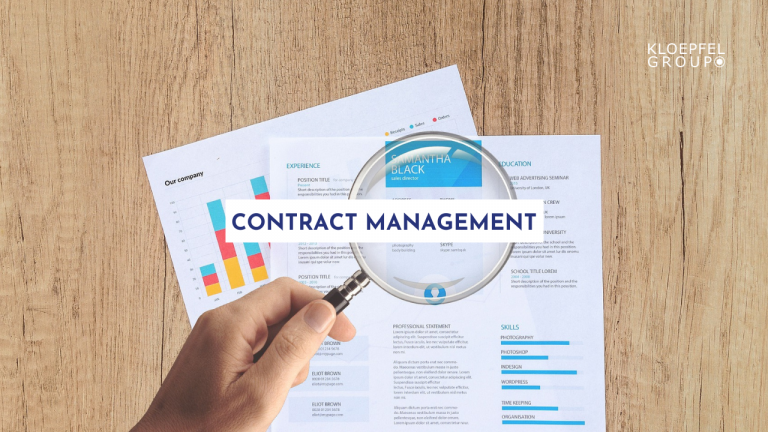- Why is contract management important?
- Why is contract management so often underestimated?
- What role does purchasing play in contract management?
- How to implement contract management with Kloepfel Consulting?
- What happens after the site analysis?
- How is the contract data entered?
- Is it possible to generate contracts with such a tool?
Authors: Marc Röver, Senior Manager Kloepfel Consulting and Henning Esser, Consultant Kloepfel Consulting
Why is contract management important?
Well-functioning contract management creates transparency about the rights, obligations, conditions and prices that companies agree with their suppliers. However, many companies and departments lack this transparency. In some cases, responsibilities are also unclear.
However, if departments and buyers know their obligations and rights vis-à-vis their suppliers, this can result in many economic benefits. For example, companies are better prepared for later negotiations if they know their contractual position and the negotiating levers that arise from the contract.
In addition, costly risks, e.g., due to missed notice periods or compliance violations, are avoided.
In addition, digitization automates contract processes (e.g., creation, signing, and administration) to save time.
Another positive effect of implementing the “contract management” process and the associated transparency across all contracts is also that budgets can be planned more easily and securely. Often, this is still done with Excel and all the information from the various departments must first be compiled. This is no longer necessary with optimized contract management.
Why is contract management so often underestimated?
Many small mistakes often remain hidden. That’s why most companies don’t usually think about the topic of contract management until, for example, a notice period has been missed and you have to pay a five- or six-figure premium too much. Or companies only realize the importance of contracts when a machine cannot be repaired because they overlooked renewing the relevant contract. In addition, there may be violations of data protection (DSGVO) or confidentiality agreements due to the lack of an NDA (Non-Disclosure Agreement). One consequence may be that the companies are warned off. License agreements that have expired unnoticed can also be a risk due to a breach of license or copyright law, which only comes to light during an audit and usually causes high costs. These are just a few of many examples from our practice.
Can you give a simple example of how a contract management system takes work away from companies?
Anyone who manages a large fleet of vehicles, for example, knows how difficult it is to keep track of all the leasing and maintenance contracts with their different terms for hundreds of cars. Optimized contract management processes take care of this. The fleet manager can then use a contract management tool to identify, at the touch of a button, which cars have which running costs or remaining terms, and so on. This also simplifies budget planning.
What role does purchasing play in contract management?
We often find that departments conclude the contracts for their area themselves and purchasing is hardly involved, if at all. This is a classic case of maverick buying. In this case, purchasing can use its know-how to get more out of the contract negotiations for the same budget than the specialist departments. However, the purchasing departments are often so busy due to the central procurement goods that, for example, the overhead costs remain unchecked. But it is precisely here that large savings potentials are often hidden.
In addition, well-managed contract management can improve relationships with suppliers and customers by making mutual rights and obligations transparent.
How to implement contract management with Kloepfel Consulting?
First, we examine the current processes, responsibilities, authorizations and IT landscape in a workshop. When it comes to the system landscape, we also check which existing tools exist for automation or partial automation (archiving systems or automatic invoice processing) that can or must be integrated. In addition, we work out with the customer who should really be responsible for which contract types. At the end, we can then create a schedule incl. effort estimation (service and software).
What happens after the site analysis?
Contract management tools only work as well as you “feed” them with data and stored processes. Therefore, such software is only part of the solution.
Before selecting and implementing software, the right processes and responsibilities must first be defined. Within this framework, we analyze how the customer currently manages its contracts. What do the review workflows look like? Who is allowed to sign a contract? When does a lawyer need to be involved? How are terms tracked? At best, this is all based on an existing purchasing policy. In this way, software can be used to ensure a certain degree of uniformity and functioning workflows. The customer also benefits from the experience we have with contracts, suppliers and purchasing.
How is the contract data entered?
After the processes and roles have been defined with the customer, we or the customer enter approximately ten to 15 key pieces of information (e.g., prices or terms) manually into the ERP system on a one-time basis. If no ERP system is connected, the data is entered directly into the contract management tool. This is necessary because a text recognition tool does not always recognize which information belongs where.
This key data is then automatically stored in the contract tool by the ERP system, so that it only needs to be entered once. The ERP system then runs the existing business processes, such as payment. Meanwhile, the contract management tool ensures that stakeholders receive a reminder when a notice period begins, for example. In addition, the PDFs of the contracts are uploaded so that they can be searched for details in the contract system using a full-text search.
The interoperability of the systems is important here, otherwise documents are stored in one place without being able to use the functions of the contract management tool.
In the implementation, we work with the provider Tract, whose tool Spider can be docked onto a wide variety of systems. However, we also use third-party modules that only work in SAP or Microsoft Dynamics, for example. In this way, we always find the right solution for the customer.
Is it possible to generate contracts with such a tool?
You can also generate your own contracts with customers from the tools. This way, you can prescribe standardized text passages and define variable information (payment conditions, customer name, etc.), which you can select with a few clicks in the tool and thus create a contract document. The important, legal standardized passages are then not changed. This works well for uniform services that one provides.
Contents workshop “Contract management”
- Process Map
- System Map
- Organizational structure of the customer if necessary with contract reference of the respective individual companies incl. stakeholders and process participants
- Contract types / categories and confidentiality
- RACI matrix for the main processes, e.g. new contract, release, contract reminder, archivehiv
- Roles and permissions
- Future project structure and stakeholders for a potential implementation
Do you want to improve your contract management? Feel free to find out more at:
Kloepfel Group
Christopher Willson
Pempelforter Str. 50 | 40211 Duesseldorf
Tel.: 0211 941 984 33 | Mail: rendite@kloepfel-consulting.com


